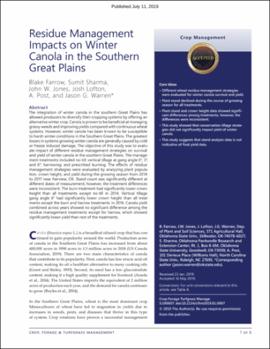| dc.contributor.author | Farrow, Blake | |
| dc.contributor.author | Sharma, Sumit | |
| dc.contributor.author | Jones, John W. | |
| dc.contributor.author | Lofton, Josh | |
| dc.contributor.author | Post, A. | |
| dc.contributor.author | Warren, Jason G. | |
| dc.date.accessioned | 2022-03-29T13:33:59Z | |
| dc.date.available | 2022-03-29T13:33:59Z | |
| dc.date.issued | 2019-07-11 | |
| dc.identifier | oksd_farrow_residuemanagement_2019 | |
| dc.identifier.citation | Farrow, B., Sharma, S., Jones, J. W., Lofton, J., Post, A., & Warren, J. G. (2019). Residue management impacts on winter canola in the southern Great Plains. Crop, Forage and Turfgrass Management, 5(1). https://doi.org/10.2134/cftm2019.05.0007 | |
| dc.identifier.uri | https://hdl.handle.net/11244/335088 | |
| dc.description.abstract | The integration of winter canola in the southern Great Plains has allowed producers to diversify their cropping systems by offering an alternative winter crop. Canola is proven to be beneficial at managing grassy weeds and improving yields compared with continuous wheat systems. However, winter canola has been known to be susceptible to harsh winter conditions in the Southern Great Plains. The greatest losses in systems growing winter canola are generally caused by cold or freeze induced damage. The objective of this study was to evaluate impact of different residue management strategies on survival and yield of winter canola in the southern Great Plains. The management treatments included no-till; vertical tillage at gang angle 0 degrees, 3 degrees, and 6 degrees; harrowing; and prescribed burning. The effects of residue management strategies were evaluated by analyzing plant population, crown height, and yield during the growing season from 2014 to 2017 near Fairview, OK. Stand count was significantly different at different dates of measurement; however, the treatment differences were inconsistent. The burn treatment had significantly lower crown height than all treatments except no-till in 2014. Vertical tillage gang angle 6 degrees had significantly lower crown height than all treatments except the burn and harrow treatments in 2016. Canola yield combined across years showed no significant difference among the residue management treatments except for harrow, which showed significantly lower yield than rest of the treatments. | |
| dc.format | application/pdf | |
| dc.language | en_US | |
| dc.publisher | Wiley | |
| dc.relation.ispartof | Crop, Forage and Turfgrass Management, 5 (1) | |
| dc.rights | This material has been previously published. In the Oklahoma State University Library's institutional repository this version is made available through the open access principles and the terms of agreement/consent between the author(s) and the publisher. The permission policy on the use, reproduction or distribution of the material falls under fair use for educational, scholarship, and research purposes. Contact Digital Resources and Discovery Services at lib-dls@okstate.edu or 405-744-9161 for further information. | |
| dc.title | Residue management impacts on winter canola in the southern Great Plains | |
| dc.date.updated | 2022-03-28T21:02:05Z | |
| osu.filename | oksd_farrow_residuemanagement_2019.pdf | |
| dc.description.peerreview | Peer reviewed | |
| dc.identifier.doi | 10.2134/cftm2019.05.0007 | |
| dc.description.department | Plant and Soil Sciences | |
| dc.type.genre | Article | |
| dc.type.material | Text | |
| dc.identifier.author | ScopusID: 57211133269 (Farrow, B) | |
| dc.identifier.author | ScopusID: 56528654900 (Sharma, S) | |
| dc.identifier.author | ScopusID: 57211133539 (Jones, JW) | |
| dc.identifier.author | ORCID: 0000-0002-1644-4648 (Lofton, J) | |
| dc.identifier.author | ScopusID: 48261217200 (Lofton, J) | |
| dc.identifier.author | ScopusID: 32667970400 (Post, A) | |
| dc.identifier.author | ORCID: 0000-0003-3622-4893 (Warren, JG) | |
| dc.identifier.author | ScopusID: 56212915300 | 7402212385 (Warren, JG) | |
